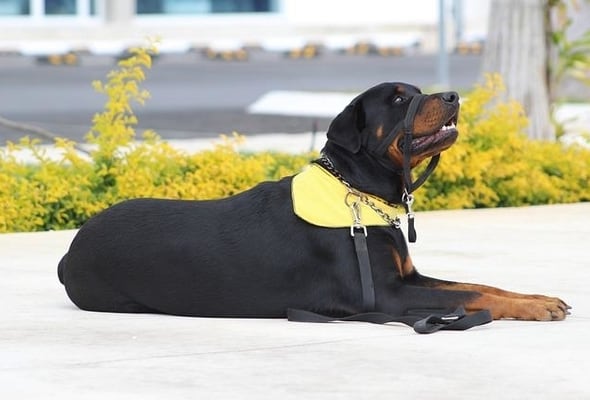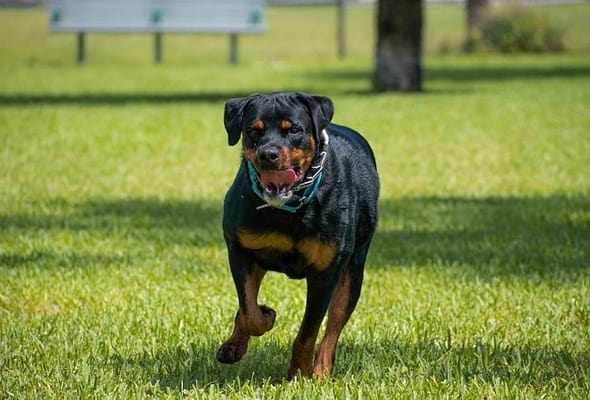Dogs have extensive histories based all around the world. From working farm dogs in Ireland to royal aristocratic companions in China, they’ve taken on many roles to become the breeds we know and love today. However, not everyone knows the background to the dog they choose to adopt.
One of the most adopted breeds in America these days is the Rottweiler. Rottweilers have a reputation of being a guard dog, but that’s not all their history entails. So, what were rottweilers bred for?
What Were Rottweilers Bred For?
Rottweilers were bred as drovers, or cattle dogs. They would guide cows, sheep, and other large livestock to keep them in line on their path throughout the journey. Eventually they were bred for the working class and assisted with heavy duty work.
They are named Rottweilers because their Roman ancestors were abandoned and mainly used as working dogs in the German city of Rottweil after the fall of the Roman Empire.
Through breeding with other dogs, thought to be the Bernese Mountain Dog and the Greater Swiss Mountain Dog, we got the German Rottweiler. They remained cattle and livestock dogs for a while, but eventually broadened their resume to include a bunch of other heavy duty tasks.
One of these tasks includes pulling carts of meat for butches, giving them the nickname “The Butcher’s Dog.” With pulling their carts, Rottweilers also were used to protect the butcher’s money on their journey due to their striking demeanor.
Besides being dogs of labor, Rotties were also some of the first police dogs. Their appearance along with their keen sense and athletic build make for the perfect companion for an officer.
What Are Rottweilers Used For Today?
For the most part, owners have abandoned the past uses of Rottweilers and mainly keep them for some company or a threatening guard dog. There are, however, still some cases of Rottweilers being used to guide livestock and pull carts on farms, so they haven’t completely forgotten their roots.

While they are still seen being police dogs, Rottweilers have also been seen coming to the aid of victims of disaster as search-and-rescue dogs. This isn’t the end of their compassionate line of work, as they also can be guide dogs for the blind, therapy dogs for children and victims of abuse, or even service dogs for their owners!
Because of their work as police dogs, there is often a perception that Rottweilers are dangerous or violent. This is not the case, as usually police dogs are bred and trained for the specifics of the job and it’s not a breed standard. A properly socialized and trained Rottweiler is gentle with children, and a loyal companion to their human family.
Rottweilers can truly be trained to do anything, and they’re happiest when they have a job to do. With proper obedience training, you can teach them to clean up their toys, fetch things for you, or whatever you want them to! They are happy to learn and tend to absorb tricks fairly fast.
Were Rottweilers Used in War?
As we said before, the Romans used the Rottweiler’s mastiff ancestors as guard dogs during the expansion of their empire. When they were left in Germany and became the German Rottweiler, they maintained their hardened reputation as aggressive guard dogs.

This created a demand for Rottweilers in Germany during World War I and World War II. They were not usually seen on the battle line, rather were very helpful behind the scenes. Rotties were used as messengers between soldiers, guard dogs, and even rescue dogs.
In World War I, trenches made it difficult for soldiers to effortlessly navigate and communicate with other soldiers. This is where messenger dogs come in, being a faster and less dangerous way to send messages.
In both World War I and World War II, Rottweilers guarded the wounded soldiers and their things while the rest were off to battle. It is not often that the dogs would be seen on the front lines, but they would have to go out to bring back any wounded or dead soldiers they could find to try and get them back to safety.
Rottweilers Almost Went Extinct
We know that the early German Rottweilers were bred to be cattle and livestock dogs. During the middle of the 19th century though, they were needed less and less as technology advanced past the need for dog labor.
The invention of railroads was great for human advancement, but not so great for Rottweilers. Trains and cattle carts were now able to do a Rottweiler’s job, but now faster and with more efficiency. Because of this, the breed started to die out as there was no longer a demand for them to be bred to work.
But thankfully, a few Rottweiler lovers noticed that the breed was dwindling, and started to breed them on their own to preserve them. With this, they gained their new jobs as butcher dogs, police dogs, and human companions.
Without Rottweilers, dog culture would be much different today and we wouldn’t have the opportunity to love these dogs as much as we do. They are essential to police work, companionship, and as service dogs.
How Have Rottweilers Changed Over Time?
As trade and national relationships evolved, so has the Rottweiler. In physical appearance, the German Rottweiler tends to have a bigger head and broader body than today’s American Rottweiler. This was not always the case though, and has come across through breeding and interbreeding.
The original German Rottweiler was thought to have weighed half as much as the ones do today. There was also a period in time where they were born with a cropped tail, due to it being needed to avoid getting in the way of the carts they pulled. However, they are now born with longer tails that can be cropped when they are still a puppy.
The German Rottweiler is still closer to the original Rottweiler than the American Rottweiler is. Germany has much stricter breeding standards and restrictions than America does, meaning there is room to evolve the breed to have different traits in America.
The American Rottweiler tends to stand taller and be slimmer than the standard short and stocky German Rottie. It is uncommon to see an American Rottie without a cropped tail, but it is a common occurrence in Germany to let them remain long.
Conclusion
From the Roman Empire to almost becoming extinct and then becoming one of the most loved dog breeds in America, Rottweilers have had a long journey. Originally bred as cattle dogs, they soon were revolutionized to be more of a companion, whether to a police officer, a soldier, or a loving family.
They have changed over time slightly, but their temperament is still reminiscent of their Roman ancestors, and some of them still work the same jobs as livestock herders.

